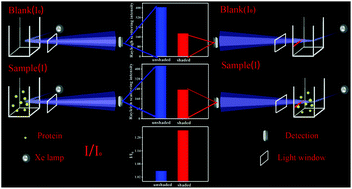The unique physical shading pattern of Rayleigh scattering for the generally improved detection of scattering particles
Abstract
The Rayleigh scattering method is a rising analytical technique because of its high sensitivity and simple operability in the detection of scattered particles. Herein, an efficient and facile physical shading method (covering the cuvette) based on the Rayleigh scattering pattern was developed, which exhibited overall promotion of sensitivity, linearity, detection limit, precision and accuracy because of its greatly reduced background noise upon measurement even if complicated chemical reagents and instruments were not involved. Protein, as a common scattering particle, is a direct or indirect expression of an organism's state of life. Thus, considering the simple and cost-effective features of the shading treatment, a combination strategy based on the probe was adapted to further enhance the performance of protein detection (the limit of detection (3σ) was reduced by at least 20 times, using Eriochrome Black T as a probe), and the possible reasons for the improvement were deduced theoretically. Furthermore, the technology was successfully applied to detect protein in human urine, giving consistent results. In general, this improvement strategy can be handily integrated into most detection systems based on Rayleigh scattering, and its realization delineates a blueprint for the rapid development of sensors.

- This article is part of the themed collection: Analyst HOT Articles 2022


 Please wait while we load your content...
Please wait while we load your content...